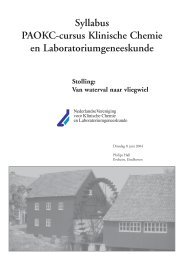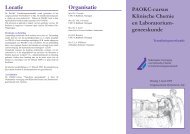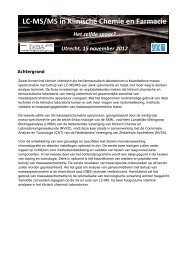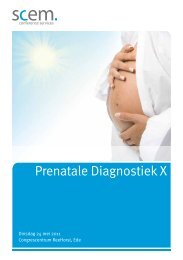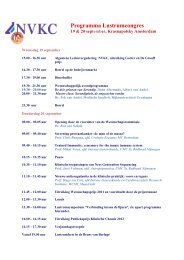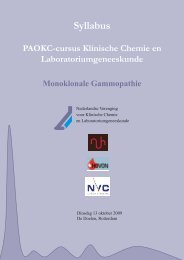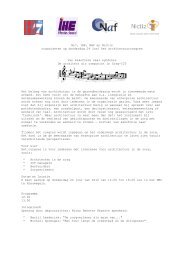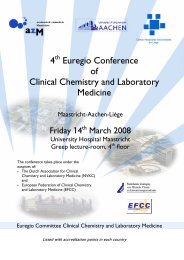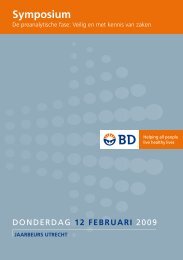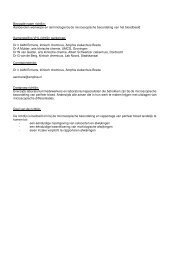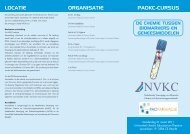SKML-Quality Mark for point-of-care test (POCT) glucose ... - NVKC
SKML-Quality Mark for point-of-care test (POCT) glucose ... - NVKC
SKML-Quality Mark for point-of-care test (POCT) glucose ... - NVKC
You also want an ePaper? Increase the reach of your titles
YUMPU automatically turns print PDFs into web optimized ePapers that Google loves.
Article in press - uncorrected pro<strong>of</strong><br />
1024 Jansen and Slingerland: <strong>SKML</strong>-<strong>Quality</strong> <strong>Mark</strong> <strong>for</strong> <strong>POCT</strong> <strong>glucose</strong> meters<br />
analytical requirements. The most important aspect in the TNO<br />
guideline is that it allows a 15% deviation in <strong>glucose</strong> values<br />
obtained with a handheld meter vs. the hexokinase method, and ISO<br />
15197 allows <strong>for</strong> a 20% deviation vs. the reference method (type to<br />
be chosen by the manufacturer).<br />
<strong>SKML</strong>-<strong>Quality</strong> <strong>Mark</strong><br />
The <strong>SKML</strong>-<strong>Quality</strong> <strong>Mark</strong> comprises the following criteria <strong>for</strong> blood<br />
<strong>glucose</strong> equipment:<br />
1. Fulfilment <strong>of</strong> compliance with ISO 15197 and/or TNO guideline<br />
criterion.<br />
2. Fulfilment <strong>of</strong> the TAE criterion.<br />
3. Fulfilment <strong>of</strong> the total allowable linearity bias criterion.<br />
4. Fulfilment <strong>of</strong> the total allowable interfering substances bias<br />
criterion.<br />
5. Fulfilment <strong>of</strong> the haematocrit criterion.<br />
If a meter failed one <strong>of</strong> the criteria, the data were inspected <strong>for</strong><br />
possible outliers that influenced the results using Box and Whisker<br />
plots. If an outlier was detected, it was removed and the results<br />
recalculated.<br />
A <strong>SKML</strong>-<strong>Quality</strong> <strong>Mark</strong> approved meter should be used by appropriately<br />
trained personnel or patients.<br />
Comparison <strong>of</strong> user-meters with the laboratory<br />
The quality <strong>of</strong> the analysis should be checked regularly using control<br />
materials <strong>for</strong> <strong>POCT</strong> equipment, and at least once a year <strong>for</strong><br />
home-use meters by comparison <strong>of</strong> a measurement by the user with<br />
the laboratory method. Assessment <strong>of</strong> a measurement on a homeuse<br />
blood <strong>glucose</strong> meter was done as follows. The patient per<strong>for</strong>med<br />
a measurement in the same manner he/she normally per<strong>for</strong>ms measurements,<br />
in duplicate. At the same time, heparin blood was collected<br />
from the patient <strong>for</strong> plasma <strong>glucose</strong>. The plasma <strong>glucose</strong> was<br />
also measured in duplicate.<br />
Results<br />
The proposed <strong>SKML</strong>-<strong>Quality</strong> <strong>Mark</strong> system was <strong>test</strong>ed as an<br />
example on 14 commercial home-use meters (Table 1). The<br />
blood <strong>glucose</strong> meters were <strong>test</strong>ed according to the procedure<br />
described in Methods. The first <strong>SKML</strong> benchmark criterion<br />
is in compliance with ISO 15197 or the TNO guideline. All<br />
14 meters fulfilled this criterion. All calculated <strong>SKML</strong>-<strong>Quality</strong><br />
<strong>Mark</strong> parameters are shown in Table 2A and B. For example,<br />
the results <strong>for</strong> the Abbot freedom lite meter (second row<br />
in Table 2A and B) included a bias <strong>of</strong> –4.2% (mean value<br />
<strong>of</strong> 75 measurements <strong>of</strong> 7.493 mmol/L vs. a hexokinase mean<br />
<strong>of</strong> 7.733 mmol/L); CV <strong>of</strong> 2.9% resulting from 10 measurements<br />
on each <strong>of</strong> five meters using the same sample with a<br />
concentration <strong>of</strong> approximately 6 mmol/L; bias and CV combine<br />
<strong>for</strong> a TE <strong>of</strong> 4.2q1.65 (2.9)s8.9%; bias at a concentration<br />
<strong>of</strong> 5 mmol/L was –7.1% (mean value <strong>of</strong> 25<br />
measurements <strong>of</strong> 4.720 mmol/L vs. a hexokinase mean <strong>of</strong><br />
5.080 mmol/L; bias <strong>of</strong> –5.3% at a concentration <strong>of</strong><br />
6.5 mmol/L (mean <strong>of</strong> 6.196 vs. 6.540); bias <strong>of</strong> –0.1% at a<br />
concentration <strong>of</strong> 11.5 mmol/L (mean <strong>of</strong> 11.564 vs. 11.580);<br />
TE <strong>of</strong> –11.9 at a concentration <strong>of</strong> 5 mmol/L resulting from<br />
a bias <strong>of</strong> –7.1% and 1.65 times the CV <strong>of</strong> 2.9%; TE <strong>of</strong><br />
–10.0% at 6.5 mmol/L resulting from the bias <strong>of</strong> –5.3% and<br />
the CV <strong>of</strong> 2.9%; TE <strong>of</strong> –4.9% at 11.5 mmol/L resulting from<br />
a bias <strong>of</strong> –0.1% and a CV <strong>of</strong> 2.9%; Table 2B: bias <strong>of</strong> –4.2%<br />
if no additive wequal to first bias column in Table 2A; acetaminophen<br />
concentration <strong>of</strong> 10 mg/L, bias <strong>of</strong> –1.3% (mean<br />
<strong>of</strong> one measurement in each <strong>of</strong> five meters <strong>of</strong> 5.980 vs. hexokinase<br />
mean <strong>of</strong> 6.060); ascorbic acid concentration <strong>of</strong> 30 mg/L,<br />
bias <strong>of</strong> –2.8% (mean <strong>of</strong> 4.240 vs. hexokinase mean <strong>of</strong><br />
4.460)x. Table 2A shows that the total error <strong>for</strong> the Wellion<br />
Linus was 16.2%, and <strong>for</strong> Glucocard X-meter was 13.4%,<br />
both larger that the TAE <strong>of</strong> 9.4%. Total error at individual<br />
levels (Table 2A) were –30.2% <strong>for</strong> Wellion Linus and<br />
–18.1% <strong>for</strong> Glucocard X-meter at the low level. Total error<br />
as 13.9% <strong>for</strong> Sensocard plus at the middle level and –13.6%<br />
<strong>for</strong> Glucocard X-meter at the high level. The presence <strong>of</strong><br />
acetaminophen resulted in bias <strong>of</strong> –12.9% <strong>for</strong> Wellion Linus<br />
(Table 2B). The presence <strong>of</strong> ascorbic acid resulted in a bias<br />
<strong>of</strong> 11.9% <strong>for</strong> Sensocard plus and 8.7% <strong>for</strong> the Glucocard X-<br />
meter. Table 3 summarizes the five <strong>SKML</strong> benchmark criteria<br />
<strong>for</strong> the 14 meters. Figure 1 shows the results <strong>of</strong> the<br />
second benchmark criterion.<br />
Discussion<br />
The quality <strong>of</strong> analytical processes has been a major topic in<br />
laboratory medicine <strong>for</strong> many years. Internal and external<br />
quality assessment makes good sense. The introduction <strong>of</strong><br />
total quality systems and accreditation has enhanced the<br />
quality <strong>of</strong> medical laboratories, including the pre- and postanalytical<br />
aspects. Since the introduction <strong>of</strong> <strong>POCT</strong>s, the<br />
necessity <strong>for</strong> quality assessment <strong>of</strong> such measurements has<br />
become increasingly clear (17). International and national<br />
guidelines and regulations put the responsibility <strong>for</strong> the per<strong>for</strong>mance<br />
<strong>of</strong> the <strong>POCT</strong> in the hands <strong>of</strong> the medical labora-<br />
Table 1 Blood <strong>glucose</strong> meters, company, type and <strong>test</strong> principle,<br />
<strong>test</strong>ed <strong>for</strong> the <strong>SKML</strong>-<strong>Quality</strong> mark.<br />
Company Type Test principle<br />
Abbott Freestyle freedom Dehydrogenase<br />
Abbott Freestyle freedom lite Dehydrogenase<br />
Abbott Freestyle lite Dehydrogenase<br />
Abbott Freestyle mini Dehydrogenase<br />
Abbott Precision X-ceed Dehydrogenase<br />
Bayer Contour Oxidase<br />
Boeren Wellion Linus Oxidase<br />
Dicomed Sensocard plus Oxidase<br />
Lifescan One touch ultra 2 Oxidase<br />
Lifescan One touch ultra easy Oxidase<br />
Lifescan One touch vita Oxidase<br />
Menarini Glucocard X-meter Dehydrogenase<br />
Roche Accuchek aviva Dehydrogenase<br />
Roche Accuchek compact plus Dehydrogenase<br />
Abbott BV, Amersfoort, The Netherlands; Bayer BV, Mijdrecht,<br />
The Netherlands; Boeren Medical BV, Tilburg, The Netherlands;<br />
Dicomed BV, Zwolle, The Netherlands; Lifescan Benelux, Tilburg,<br />
The Netherlands; A. Menarini Diagnostics Benelux NV, Valkenswaard,<br />
The Netherlands; Roche Diagnostics Nederland BV,<br />
Almere, The Netherlands.



